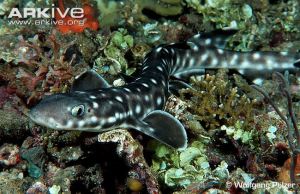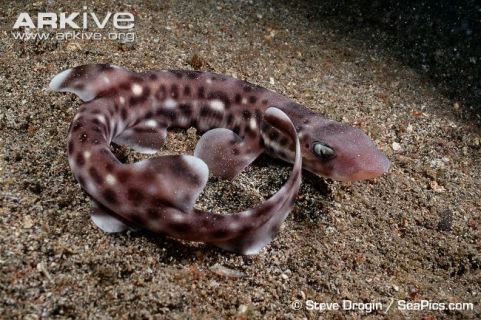When discussing deep sea sharks in previous posts, we acknowledge that little is known about them. The deep, dark, and hard to reach places of the ocean present a challenge to researchers that wish to observe and study them in their natural habitats. However, even sharks that live closer to the surface can be difficult to research! Habitats within the photic zone have their own set of challenges to contend with. Scientists are constantly innovating and refining techniques to study these fascinating creatures in their natural habitat. This week’s featured creature is yet another hard-to-study shark, the Coral Catshark (Atelomycterus marmoratus).
 What we do know is that it is a common and abundant shark that lives in the shallows and within crevices of coral reefs in the Indo-Western Pacific. Like most catsharks, it has elongated and cat-like eyes. It has a slender body only reaching about 2.3 feet long. A beautiful coloration on this shark with saddle markings that have black spots which forms bar marks that bonds the saddles and large white spots. This shark is oviparous (egg laying) and lays pairs of egg-cases, once or twice per month. During the breeding season, 44-52 baby Coral Catsharks can be hatched. They are also harvested, though not for food. Because the Coral Catshark is so visually appealing and can adapt and hatch well in captivity, they are very popular home aquarium sharks.
What we do know is that it is a common and abundant shark that lives in the shallows and within crevices of coral reefs in the Indo-Western Pacific. Like most catsharks, it has elongated and cat-like eyes. It has a slender body only reaching about 2.3 feet long. A beautiful coloration on this shark with saddle markings that have black spots which forms bar marks that bonds the saddles and large white spots. This shark is oviparous (egg laying) and lays pairs of egg-cases, once or twice per month. During the breeding season, 44-52 baby Coral Catsharks can be hatched. They are also harvested, though not for food. Because the Coral Catshark is so visually appealing and can adapt and hatch well in captivity, they are very popular home aquarium sharks.
Join us next week as we look at a shark that we can find right here in the San Francisco Bay.
References:
Edited by KC O’Shea
Photography: Pictures from ARKIVE Steve Drogin and Wolfgang Polzer
White, W.T. (SSG Australia & Oceania Regional Workshop, March 2003) 2003. Atelomycterus marmoratus. The IUCN Red List of Threatened Species. Version 2015.2. <www.iucnredlist.org>. Downloaded on 08 July 2015.
http://species-identification.org/species.php?species_group=sharks&id=325&menuentry=soorten


Leave a comment